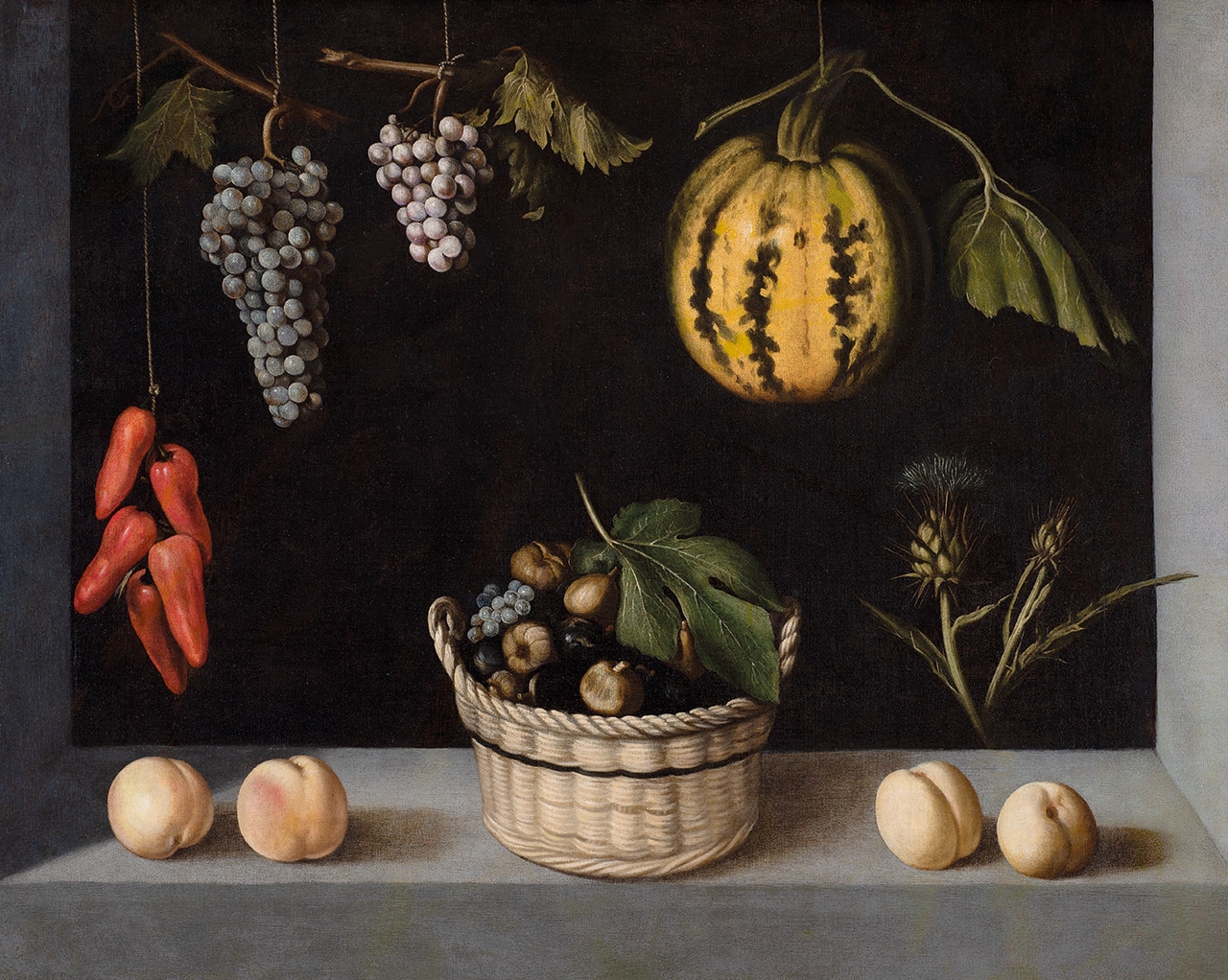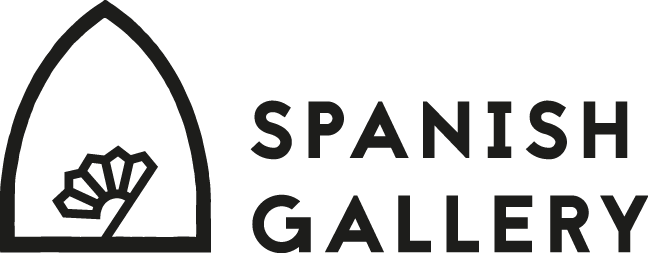
Still Life with Basket of Fruit, Melon, and Grapes
Strongly lit against a dark background, the objects are carefully arranged in a window frame and depicted from slightly above. In the centre of the ledge is a basket containing figs, grapes, and vine leaves, which is flanked on either side by two apricots. A bunch of red peppers, two bunches of blue grapes, and a melon hang from above, alongside an invisible curve. On the far right, a thistle appears from behind the ledge, which enhances the illusion of spatial depth.
The window space recalls a pantry (or cold room, known as a fresquera in Spanish) where vegetables were traditionally kept fresh. The artist’s composition however does not correspond to the mere haphazard storage of foodstuffs in a pantry. Effectively, he has taken the objects out of their original context and arranged them according to purely aesthetic criteria. With each object finely painted in isolation and sharply lit from the upper left, the composition invites the viewer to appreciate ordinary things in a new manner. Looking closely, we can admire the different colours, shapes, surfaces, and textures of the objects, such as the velvety skin of the apricots, the translucent grapes, the rubber-like surface of the melon, and the fine weave of the basket.
The distinctive window-composition directly relates this work to the pioneering still lifes painted by Juan Sánchez Cotán (1560–1627) in Toledo before 1603. In accordance with Renaissance theory, still-life painting was generally regarded as nothing more than an artist’s distraction and as a genre greatly inferior to the depiction of the human figure, especially in religious paintings, which had the specific purpose of inspiring faith and devotion. Yet the art theorist, Francisco Pacheco, praised still-life painting nonetheless as an opportunity for artists to show off their inventiveness in creating unique compositions and to draw attention to their mimetic skills. With regard to the emphasis on the imitation of the natural world, art writers often referenced the story of Zeuxis, a classical painter known through Pliny the Elder’s Natural History. According to this, Zeuxis had painted grapes in such a realistic manner that birds flew down and pecked at the painted fruit.
The symbolic dimension of a still-life painting, like this one, is uncertain. On the one hand, viewers might have admired it for the accurate depiction of the objects and the meditative quality of the picture. On the other, they might have also appreciated it in more religious terms, based on the belief that all natural things, even the most humble, are God’s creation and are therefore a manifestation of his presence.
Other Spanish artists who painted similar compositions include Alejandro de Loarte (c. 1590–1626), Cristóbal Ramírez de Arellano (active 1630s–40s), Blas de Ledesma (1580–1640), Juan van der Hamen (1596–1631), and Francisco de Zurbarán (1598–1664).
 Click to zoom and pan
Click to zoom and pan
...
Your feedback is very important to us. Would you like to tell us why?
We will never display your feedback on site - this information is used for research purposes.
Artwork Details
Title
Still Life with Basket of Fruit, Melon and Grapes.
Artist
Attributed to the Stirling-Maxwell Master (active in Toledo and Madrid in the early seventeenth century).
Date
c. 1610–40.
Medium and Support
Oil on canvas.
Dimensions
73.5 x 96.3cm.
Marks and Inscriptions
None.
Acquisition Details
The Zurbarán Trust, 2017.
Previous Owners
Sold by Galeria Cisne, Madrid to Manuel Puertas Casamitjana in March 1964; with Sotheby’s in 2017.
Institution
The Spanish Gallery, Bishop Auckland.
Bibliography
Peter Cherry & William B. Jordan, Spanish Still Life from Velázquez to Goya (London: The National Gallery, 1995), p. 188;
William B. Jordan, An Eye on Nature: Spanish Still-Life Paintings from Sánchez Cotán to Goya (New York NY: Matthiesen Fine Art, 1997), p. 39;
Peter Chery, Arte y naturaleza: el bodegón español en el Siglo de Oro (Madrid: Doce Calles, 1999), p. 83;
James Macdonald & Edward Payne, ed., The Auckland Project at Sotheby’s: Paintings from The Spanish Gallery (New York: Sotheby’s, 2018), p. 72;
Jonathan Ruffer, Adam Lowe, & Charlotte Skene Catling, The Spanish Gallery: A Guide to the Works of Art (Bishop Auckland: The Spanish Gallery, 2021), pp. 29–31.
